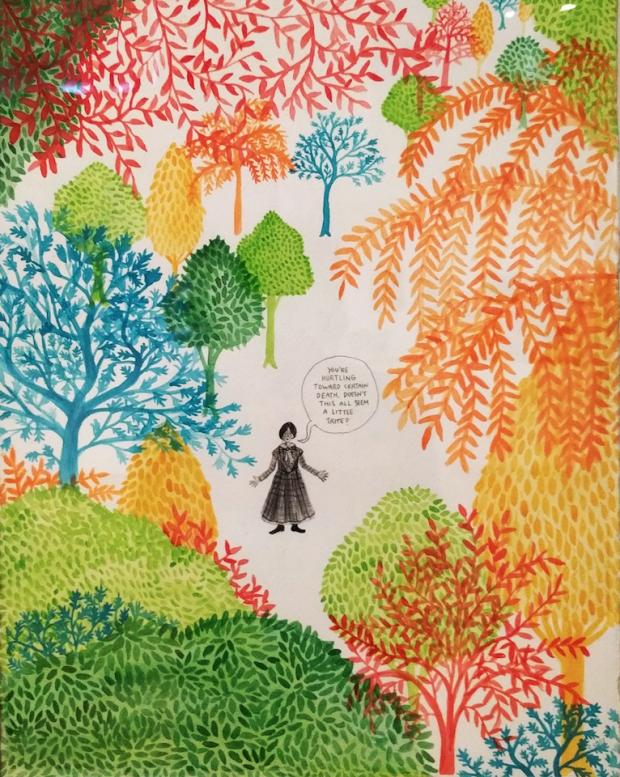Hallwalls Members' Exhibit
The usual rule about artworks in a gallery is “Don’t Touch.” In the Hallwalls Members’ Exhibit, artist Kyla Avery Kegler turns the rule around, inviting viewers to touch her work, an abstract painting with the somewhat ungainly title Creamsicle Melting Water–Balloon Fight Fresh Blacktop Driveway Woodward Summer 1997 (Somatic Color #48). Because “you and I are collaborators,” she says in a direct address message to the viewer, on the label tag just under the piece. Precisely right. Most notably with abstract art, but with any work of art. Without the viewer/collaborator, it’s a tree falling in the forest. Does it make a noise? Does it even fall? Was it even a tree? Was it anything? “We enable each other’s present modes of existence,” the message goes on. (Sometimes it’s hard to know if the message is from the artist or the art. But it seems to work either way). “We have no autonomous agency…we hold each other accountable…My work and I exist through you. I need you to help me understand what this experience means, now that it belongs to you.”
The Kegler piece is on a wall of mainly abstracts plus one literalist seemingly skeptical work by R. D. Schroeck, consisting of crudely painted letters spelling out the phrase “Post modern art” over the single word “Hoax.” Other walls, other genres, pretty much. A wall of more or less portraits, another with several electronic or electronics reference works, another of landscapes and nature scenes. Also, a flowers wall, and an animals wall, and what might be described as an op effects wall, and what might be described as a visionaries wall. Another wall has several cross-out works—art about editing, in a larger context than word choice. Nearly a hundred and fifty artworks in all.
The abstractions wall includes a painting by Dorothy Fitzgerald in bold gestural brushstrokes around and over some sketches of animals. A sheep, a chicken. Maybe several chickens. And a color disk with painted rope attachment by Frank O’Connor, near a double diamonds geometrics patterns work by Ciarán Ó Conchúir.
The landscape and nature scenes wall includes a forest scene with a subtly otherworldly quality by Nancy Traherne Craig, and a meditative more domesticated scene—more orchard than forest, in somber palette—by Monica Angle. And forest canopy vignette encaustic monoprint by Mark Lavatelli.
The electronics wall includes an enigma sensibility video by Axel Sack that seems somehow about disconnects. About things askew, in some of the various ways they might be askew. It opens with a head shot of a girl silently mouthing words out of sync with a subscript message addressing the out of sync matter. Then a middle segment where it’s hard to know what’s going on. Then final segment of what looks at first like war reporting footage, but turns out a computer game search and destroy operation, though maybe really about the thrill of blowing people away with a short burst of fire from an automatic weapon. Along the same wall, one of Marc Tomko’s viewing boxes flashing one hundred Jackson Pollock or Pollock imitation paintings in black and white. And an electronics reference piece, Dan Carey’s acrylic and marker reprise chart of a week’s evening TV programs from back in the day. Happy Days, Mork and Mindy, Barney Miller, and Rockford Files in prime time.
The op effects wall features a work resembling an enormous fingerprint by Stephen Ansell, an encaustic monotype webwork by Beth Pederson, and a micro-art item complete with viewing lens by Gerald Mead.
The cross-outs wall includes Dana Tyrell’s piece called Ex-boyfriend, a blue satin sash with the gold-lettered legend “Prom King” blacked over, and William Bergmann’s World History Revised, an encyclopedia page with every line—every word, except the topic words—neatly blacked out.
The visionaries wall includes a portrait of Barack Obama and some visionary abstract works such as Frani Evedon’s archival pigment print Parasol—a little evocative of an aurora borealis—and Becky Koenig’s watercolor Green Thoughts, floating weightless irregular polyhedrons.
The show continues through August 25.

